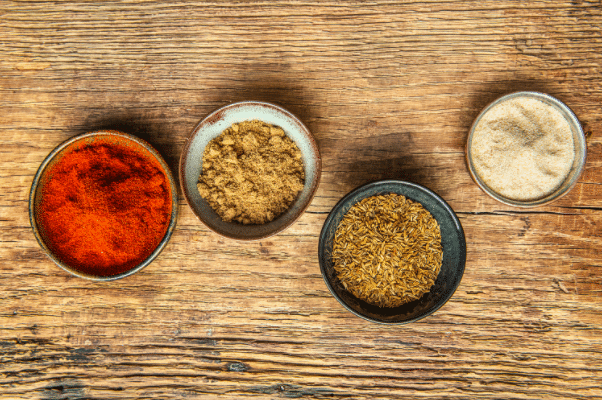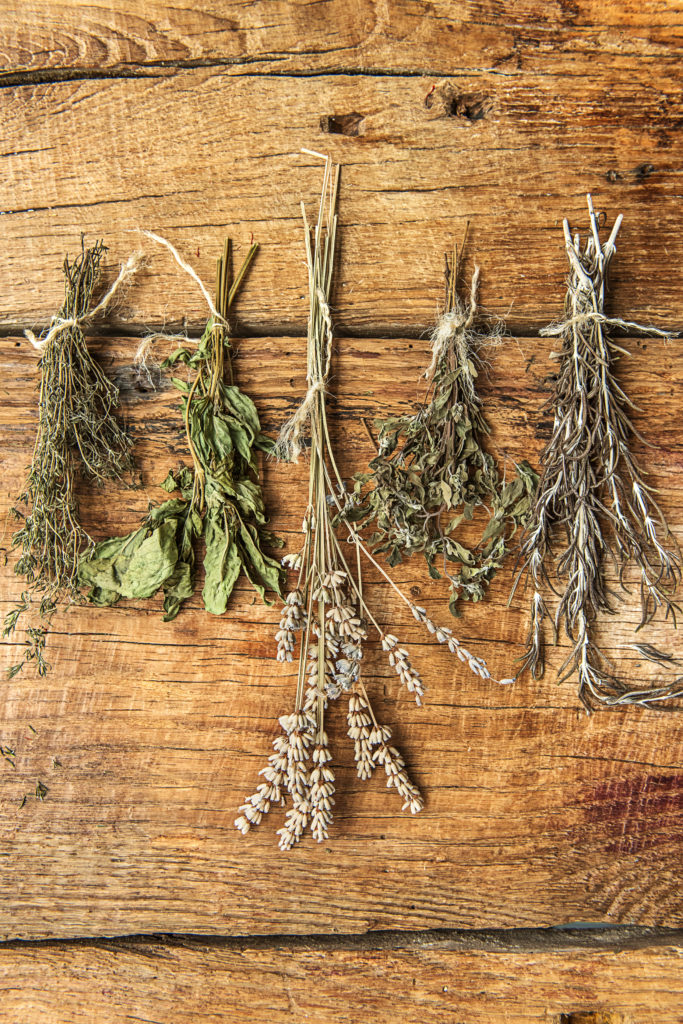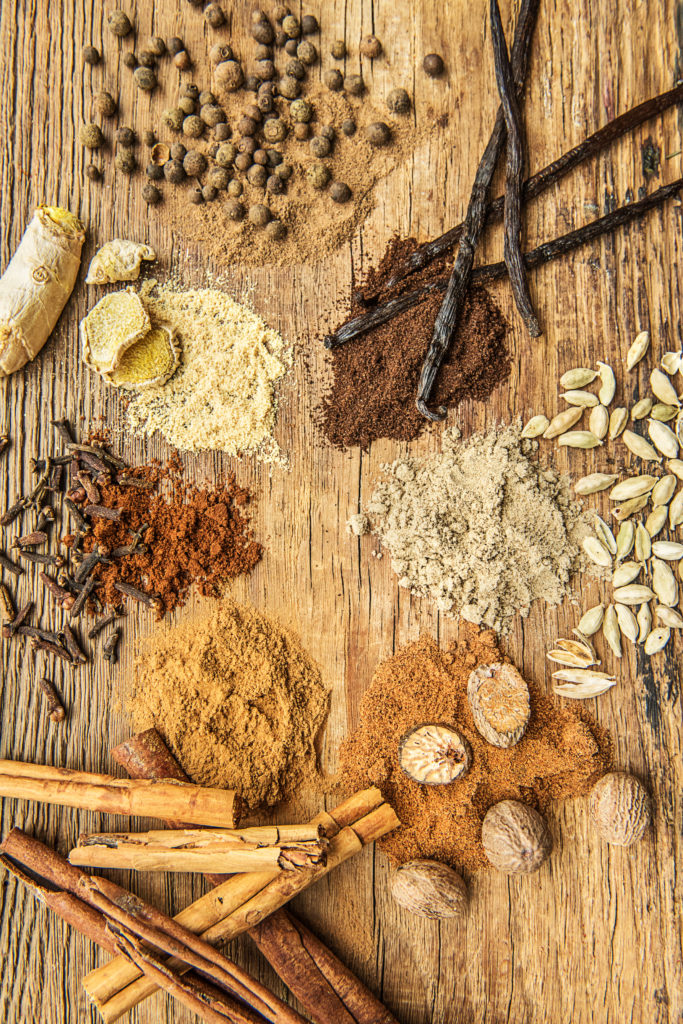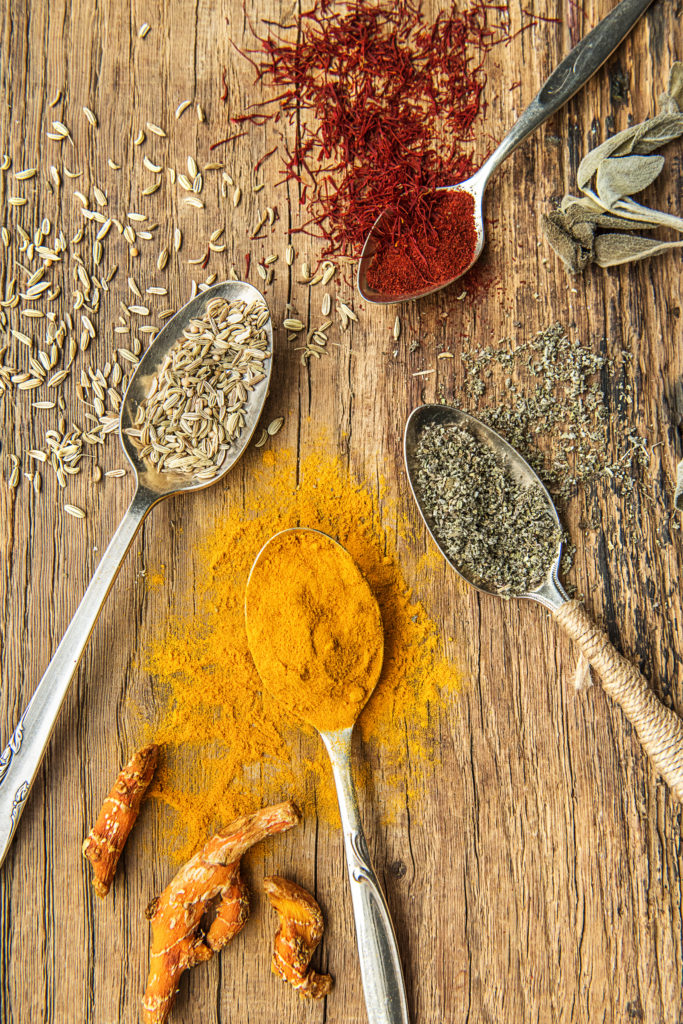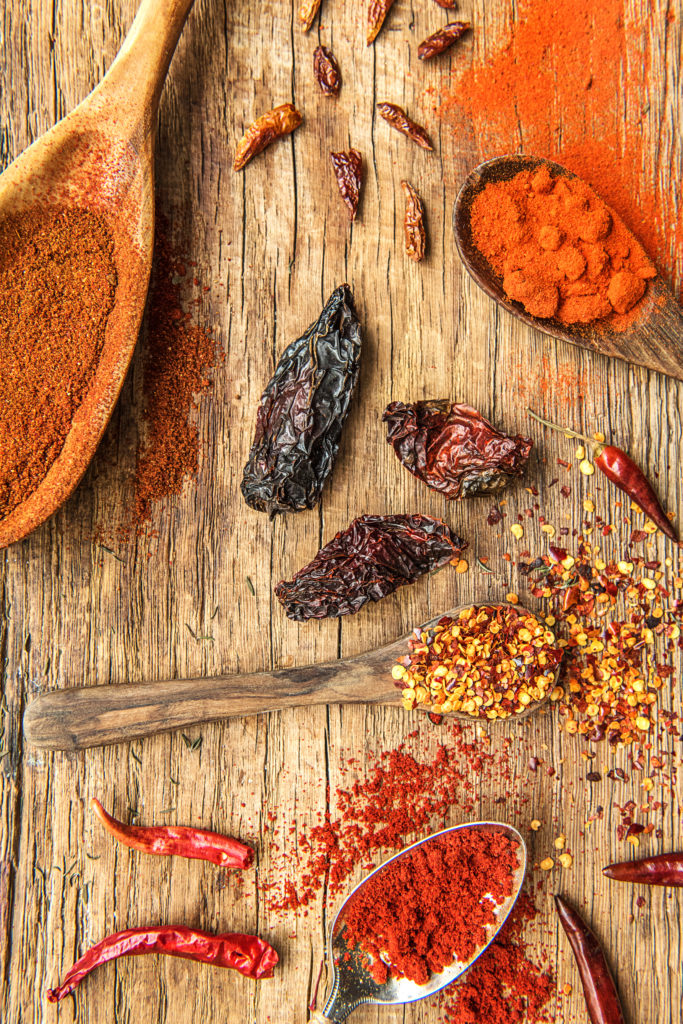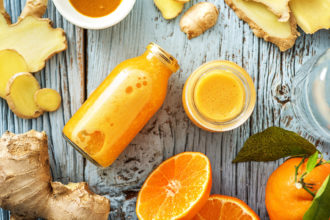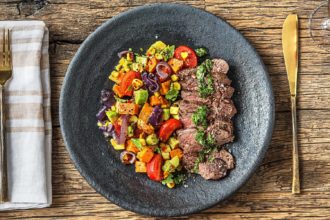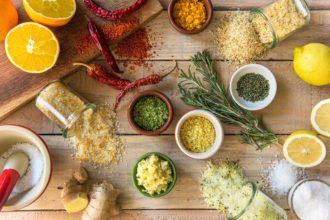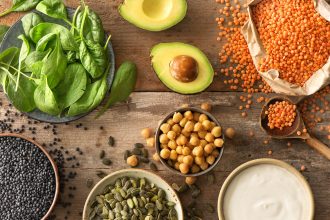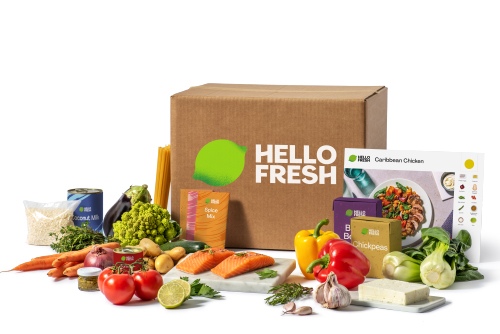How to Harness the Power of Herbs and Spices February 20, 2020
Herbs and spices are part of a rich story grounded in medicine, economy, and cooking. Today, chefs use aromatics to add delicious flavor — and you can, too.
Ever take your first bite and thought about how that perfectly flavorful bite of chicken got to be so crave-worthy in less than thirty minutes? Well, we really have herbs and spices to thank!
Historically, herbs and spices have been one of the most sought-after goods traded. At one time, they were considered more valuable than gems and gold. This led to many wars as kingdoms raced each other to monopolize the spice trade. The victors of these wars became empires with vast fortunes. More importantly, the search for new spices led to a thrilling age of travel and exploration.
However, before herbs and spices were used as the currency our economy was built upon, their original purpose was medicinal. Before we had the corner drug store or prescriptions issued by doctors, many ancient remedies used the therapeutic power of herbs and spices to prevent and treat disease. In fact, modern-day medicine is studying the active components of herbs and spices and validating many of their health properties.
Throughout history, we have used herbs and spices to make foods taste better — to give them a depth of flavor and deliciousness. Moreover, as the spice trade grew across all continents, the flavors of different cultures and their use of herbs and spices have made their way into a vast variety of recipes. In fact, a recent Cornell study looked at the ingredients lists of about 4500 recipes from 100 cookbooks. They discovered that 93% of recipes had at least one spice in them, and the average recipe had four spices.
What we can learn from all of this, is that herbs and spices play an integral role in defining our history, culture, and cuisines. As people have moved and migrated, the flavors of their traditional recipes have traveled along with them. The use of herbs and spices tells a story that allows us to travel right from the heart of our kitchens.
Most Commonly Used HelloFresh Herbs and Spices
One of the ways we like to add delicious flavor to our meals is with both individual herbs and spices as well as custom blends. In fact, we have over 70 different blends that we’ve used at one time or another. That said, there are a handful of spices we love to use over and over again for the flavor and aromatics they bring to a dish.
Garlic Powder
- This is the MOST used spice in our kitchen. We’ve blended garlic powder in more than half our spice blends. It’s not just HelloFresh that loves garlic though — this spice flavors virtually every cuisine in the world.
- The delightful aroma of garlic is due to a compound called allicin. The flavor can range from mild and sweet to pungent and powerful — however, all varieties mellow when cooked.
- Garlic tastes delicious in most savory dishes, providing a stronger flavor when used raw and a sweeter flavor when cooked. Be careful though, burning garlic will make it taste bitter.
Paprika
- Paprika is a spice that comes from dehydrated and ground up bell pepper. It can range from mild to mildly spicy depending on the variety of pepper, and can add either a sweet or smoky flavor.
- Beautifully bright red, we often use paprika to season and add color to a dish.
- Paprika originates in Eastern European cuisine but has found its way into many other cultures as well. It makes a lovely addition to sauces, stews, and rice-based dishes. You can try it yourself with this Skillet Chicken Paprikash recipe.
Cumin
- Cumin is an unassuming spice, that once cooked adds a rich and zesty flavor. In fact, this spice is often a core component of many different spice blends across the kitchens of North Africa to India to Latin America.
- As our customers favor Mexican cuisine, we love to use cumin in our tacos and fajitas -but this spice also adds a zingy flavor to chili, guacamole, and eggs as well.
- Need some inspiration? Check out our post on 5 easy Mexican recipes your kids will love.
Coriander
- For those who dislike the flavor of cilantro, it may surprise you to learn that coriander is actually the seed of the cilantro plant. While some experience cilantro as bitter and soapy, coriander is much milder with a nutty flavor of sage and orange.
- Coriander is best in combination with other spices. Add coriander to cumin, turmeric, oregano, and garlic for a savory blend. Or combine coriander with allspice, cardamom, and coconut for a sweeter blend.
Herbs vs Spices
Most people differentiate herbs and spices by defining the herb as the leafy part of the plant and spices as everything else (like the root, bark, stem, fruit, or seed).
Oregano
- We find oregano most commonly in Italian dishes. In fact, many Italian restaurants or pizza joints have this herb on the table right next to the salt and pepper.
- Most of the oregano we use in the US comes from Turkey, which exports 20 tons a year.
- Oregano has a strong flavor and can overpower a dish so it’s best to cook with the dried form. When using fresh, it’s great in marinades for meats or as an infusion into oils as a dressing
Thyme
- Thyme has a smoky scent and intense flavor, which is delicious when infused in sauces, soups, and stews.
- There are more than 100 different varieties of thyme, but the kind we use the most is French thyme.
- The active compound in thyme is thymol, and it makes a great antiseptic. The volatile oil is so effective, it’s the main ingredient in the mouthwash Listerine!
- See this herb shine in our Wild Mushroom and Thyme Risotto.
Basil
- Basil has a lush and sweet fragrance that lends itself to dishes with fresh tomatoes, roasted peppers, and dishes with olive oil. It’s probably best known as the defining ingredient in pesto.
- When fresh, this herb is extremely sensitive to temperature — it loves the warmth and will wilt if it’s put into the cold. In other words, keep it out of the fridge and on your countertops where it will flourish.
- While many associate basil with Italian and Mediterranean cuisines, it’s a plant that is actually native to India, Southeast Asia, and North Africa.
Rosemary
- Rosemary has a robust and powerful aroma that brings to mind pine-like, woody, minty, and peppery flavor.
- This delicious herb holds up in high temperature and long cook time recipes. It also combines well with honey, garlic, wine, and on roasted veggies.
- You can even try basting steak with a rosemary branch as one of the ways to infuse deliciousness when cooking the perfect steak.
Warming Spices
There are certain spices that have a thermogenic effect — they literally heat up the core temperature of the body. This increases blood circulation and can boost metabolism as well. Perhaps because of their warming effect on us, we also associate warming spices with the fall and winter months. Using a combination of the spices below creates a blend that gives delicious warm comfort — like in this Pumpkin Spice Latte recipe which is sure to make you feel like you’ve just been hugged by autumn!
Cinnamon
- With its spicy and sweet flavor, cinnamon is easy to love and used in both sweet and savory dishes across the world. Experiment with this spice by cooking up our Maple-glazed Pork Chops with Sweet Potato Mash and Green Beans.
- This spice is from the bark of a tropical evergreen tree. Once ground, cinnamon loses its fragrance — so, it’s best to buy whole sticks and grind them as needed.
- More than just a delicious flavor, cinnamon helps stabilize and control blood sugar. Furthermore, the active component, cinnamaldehyde, has also been shown to increase insulin sensitivity and HDL cholesterol (the good kind).
Ginger
- Ginger has a tangy and sweetly spicy flavor. It grows primarily in India, but most of what is available in the US is from Hawaii. It is extremely versatile and is in everything from savory kimchi to sweet gingerbread cookies.
- Southeast Asian countries use ginger the same way we use garlic in the US. We’ve used this spice in our Roasted Acorn Squash & Coconut-Curry Sauce with Gingered Fried Rice.
- Ginger is rich in the phytonutrients gingerols, which help to reduce symptoms of nausea and vomiting. This spice is an effective treatment for when pregnant women experience morning sickness or when someone gets seasick.
Cardamom
- A relative to the ginger family, cardamom has a delicately sweet, pleasant bite, and earthy flavor.
- It is one of the main spices in chai tea — and in Arab countries, they brew cardamom coffee.
- One of the powerful antioxidants in cardamom is cineole. It is an anti-inflammatory and anti-spasmodic agent that helps improve digestion and respiratory ailments.
Cloves
- Cloves have a warm, sweet flavor and are the dried flower buds on the evergreen trees from Indonesia.
- The volatile oil in cloves is eugenol. It is a mild anesthetic that creates a warm and soothing sensation — especially in the dentist’s office. You may also find it in ointments to relieve joint pain.
- Cloves also help dilate capillaries that brings blood to the surface, which in turn boosts blood circulation.
Healing Spices
It’s easy to recognize the health impacts of fruits and veggies because of how nutrient-dense they are — containing vitamins, minerals, and antioxidants. Spices also add to a healthy diet because they contain a variety and abundance of different phytonutrients than those found in produce.
Turmeric — The All-Around Champion
- Turmeric is often the main ingredient in curry spice and is most often in Indian and Southeast Asian cuisines. It smells like ginger and orange with an earthy and peppery taste. When cooking with turmeric, the flavor mellows out and the spice gives a vibrant yellow color to the dish.
- The active component inside it is curcumin. It is incredibly rich in antioxidants and anti-inflammatory actions – protecting virtually every organ in the body. Turmeric has been found to help fight over 70 different maladies like infections, headaches, digestive issues, cancer, heart disease, and type 2 diabetes. It even improves blood flow and helps to clear up skin problems.
- Want to make the effects of turmeric even more potent? Combine it with black pepper to enhance the absorption of the curcumin. If you’re unsure how to use this all-around spice champion, check out these 4 healing recipes with turmeric we love.
Saffron — Mood Lifter
- This exquisite spice has an oaky wine-like aroma and a honey-like flavor with an earthy bitter aftertaste. Additionally, when cooking with saffron, it gives off a gorgeous and intense orange-red color.
- Saffron is the most expensive spice — a pound of it goes for about $5000! This is in part because saffron is hand-picked from the dried stigma of a blue saffron crocus. That one pound requires 80,000 crocus flowers!
- There are two compounds in saffron, crocin and safranal, which protect the levels of brain chemicals like serotonin and dopamine. This makes saffron a natural remedy for fighting depression and can help increase mood.
Sage — Brain Booster
- With its robust, piney, warm, and balsamic-like aroma, sage has a strong flavor. It pairs well with fattier foods and is excellent as an infusion into butter-based dishes and charcuterie.
- Related to the mint family, sage originates from the Mediterranean region of the world.
- Scientific studies have shown that sage refreshes concentration, improves, and protects memory, as well as provides a sense of calmness. This is due to its ability to block the action of an enzyme that destroys acetylcholine (the brain chemical that plays a role in memory).
Fennel — Female Pain Reliever
- All parts of the fennel plant (vegetable, leaves, and seeds) have an immediately recognizable smell and taste of licorice.
- You can find fennel in many different cultural cuisines including Italian sausages, German breads, French sauces, and Indian curries.
- The phytochemical inside fennel is anethole and acts as an analgesic — similarly to aspirin. A common use of fennel seeds is to help relieve the pain of menstrual cramps. It also helps increase circulation in the ovaries and improves blood flow.
Demystifying Spicy Spices
Anti-inflammatory and sure to set your tongue on fire, the spicy chili pepper serves the dual purpose of being a red-hot healer and packing in the flavor. There are over 3000 different varieties of chilis, and one thing they all have in common is that they contain a compound called capsaicin. The more capsaicin in a chili pepper, the higher degree of heat you’ll experience and the more therapeutic the chili is for you.
The healing properties of chilis lie in their ability to trigger the release of a hormone called somatostatin that decreases inflammation. We can consume chilis in food, as well as apply topical ointments that contain capsaicin to provide an anesthetic effect — especially for arthritis and nerve pain. Additionally, capsaicin provides the benefits of raising your body heat, increasing perspiration, and boosting your metabolism.
Beyond capsaicin, chilis also lend powerful flavor to food and add to the culinary adventure of cooking. Listed out below are peppers that range from mild to potent. And, if spicy is your thing, we have some recipes for how to use fresh chili peppers to make your own hot sauce.
- Bell Pepper and Poblanos — Give off almost no heat
- Green Jalapeños and Chipotle — Give off a mild heat
- Serrano and Cayenne — Give off a medium heat
- Habañeros — Gives a potent high heat
- Ghost Chili Pepper & the Trinidad Scorpion Moruga — The hottest peppers on the planet
HelloFresh Spice Blends
We’ve had so much interest in the spice blends used at HelloFresh, that we made a video showing you exactly how to remake them at home. Watch below for inspiration:
With all this new information about the healing properties and delicious flavor potential of herbs and spices, it’s time to get in the kitchen and get cooking! Even better, combine the intense aroma of working with herbs and spices by inviting a friend along for the journey — because cooking together is better than pretty much anything.


